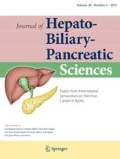Abstract
Many biliary misidentification injuries occur due to error traps-methods that work well in most circumstances but which are apt to under certain conditions. We have identified four such traps from an extensive experience in repair of biliary injuries. The most common cause of misidentification results from the “infundibular technique” error trap. This problem is usually associated with severe inflammation which hides the cystic duct and obliterates the triangle of Calot making the common hepatic duct appear to be part to the gallbladder wall. Another error trap — the “fundus-down” cholecystectomy has been associated with injuries in which the vascular component of the injury has been even more serious than the biliary one ie, “vasculo-biliary injuries” These vasulo-biliary injuries result in hepatic infarction requiring liver resection, possibly including transplantation. As opposed to the infundibular technique error trap the fundus down error trap usually occurs at open cholecystectomy after conversion. The two other error traps are due to failure to perceive the presence of an aberrant right hepatic duct on cholangiography and injury to the common bile duct in the case of a “parallel union” cystic duct. Knowledge of these error traps and their avoidance can help to reduce the incidence of biliary injuries.
Similar content being viewed by others
References
Reason J. Human error: models and management. BMJ 2000;320:768–770.
Strasberg SM, Eagon CJ, Drebin JA. The “hidden cystic duct” syndrome and the infundibular technique of laparoscopic cholecystectomy — the danger of the false infundibulum. J Am Coll Surg 2000;191:661–667.
Strasberg SM, Hertl M, Soper NJ. An analysis of the problem of biliary injury during laparoscopic cholecystectomy. J Am Coll Surg 1995;180:101–125.
Raj PK, Castillo G, Urban L. Laparoscopic cholecystectomy: fundus-down approach. J Laparoendosc Adv Surg Tech A 2001;11:95–100.
Bornman PC, Terblanche J. Subtotal cholecystectomy: for the difficult gallbladder in portal hypertension and cholecystitis. Surgery 1985;98:1–6.
Ferguson CM, Rattner DW, Warshaw AL. Bile duct injury in laparoscopic cholecystectomy. Surg Laparosc Endosc Percutan Tech 1992;2:1–7.
Flum DR, Dellinger EP, Cheadle A, Chau L, Koepsell T. Intraoperative cholangiography and risk of common bile duct injury during cholecystectomy (see comment). JAMA 2003;289:1639–1644.
Warrren KW, McDonald WM, Kune GA. Bile duct strictures: new concepts in the management of an old problem. In: Irvine WT, editor. Modern trends in surgery. London: Butterworth; 1966.
Hugh TB. New strategies to prevent laparoscopic bile duct injury — surgeons can learn from pilots. Surgery 2002;132:826–835.
Way LW, Stewart L, Gantert W, Liu K, Lee CM, Whung K, et al. Causes and prevention of laparoscopic bile duct injuries: analysis of 252 cases from a human factors and cognitive psychology perspective. Ann Surg 2003;237:460–469.
Author information
Authors and Affiliations
About this article
Cite this article
Strasberg, S.M. Error traps and vasculo-biliary injury in laparoscopic and open cholecystectomy. J Hepatobiliary Pancreat Surg 15, 284–292 (2008). https://doi.org/10.1007/s00534-007-1267-9
Received:
Accepted:
Published:
Issue Date:
DOI: https://doi.org/10.1007/s00534-007-1267-9



